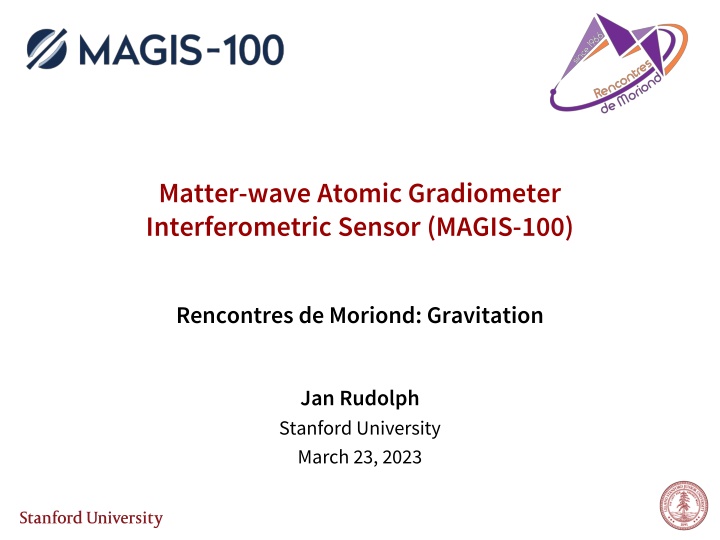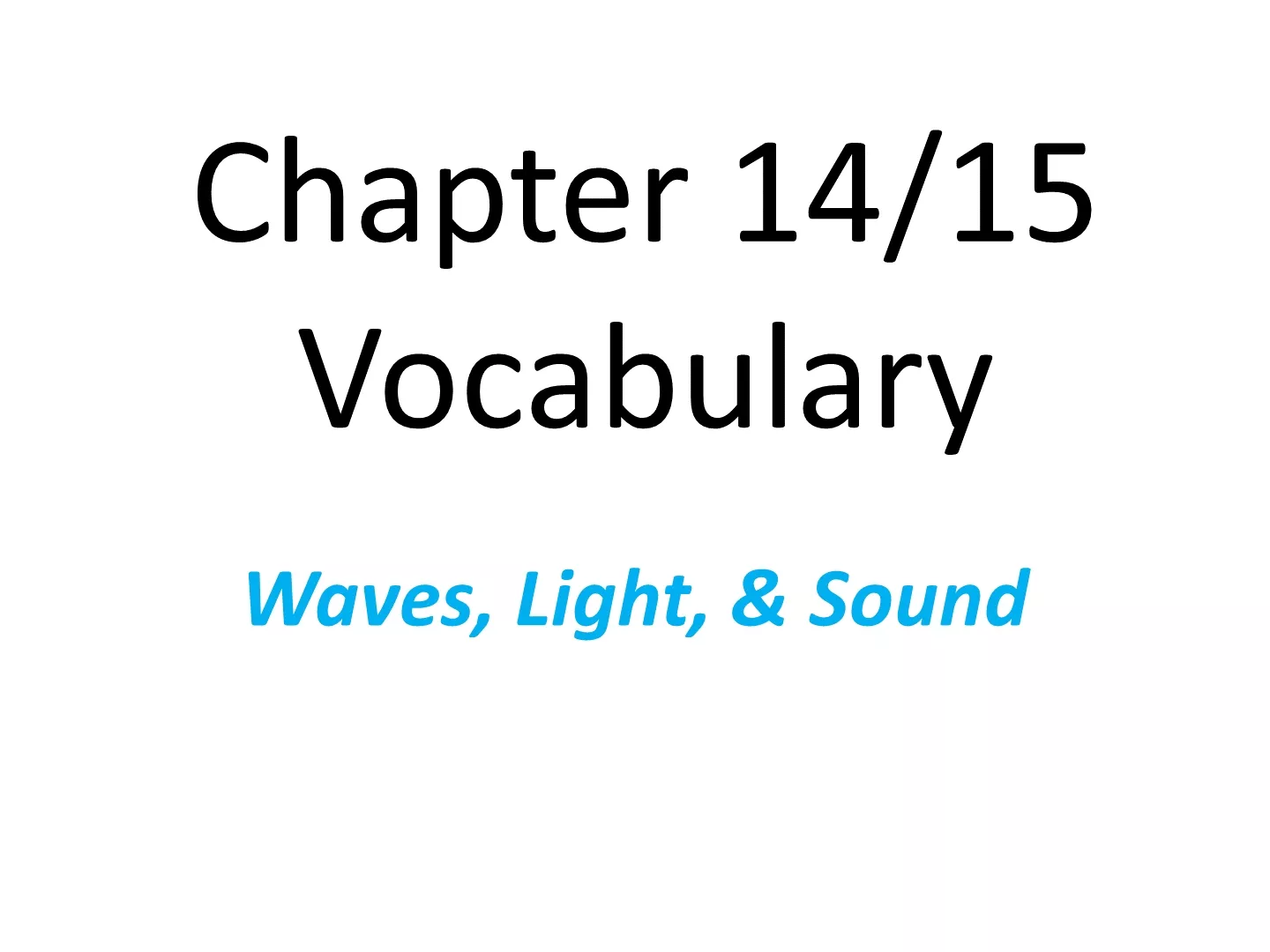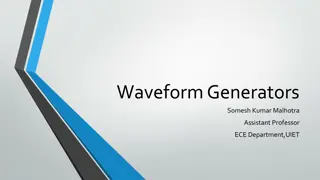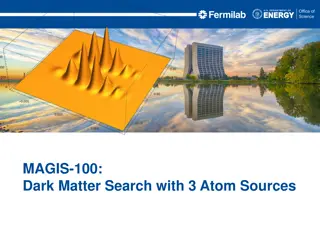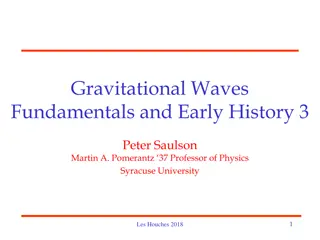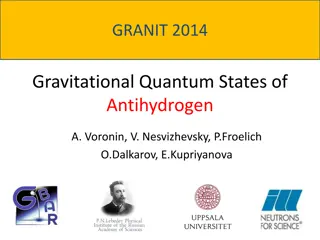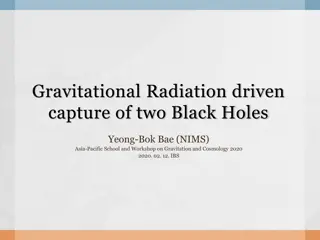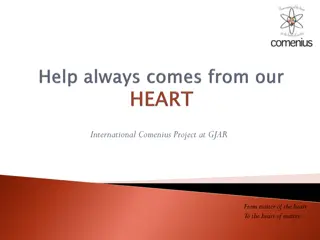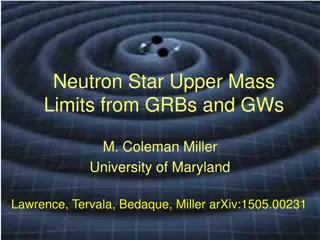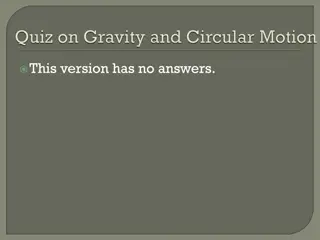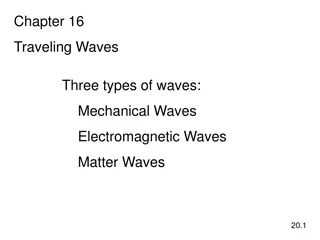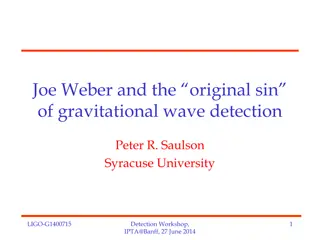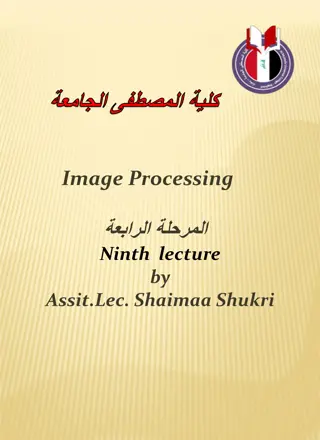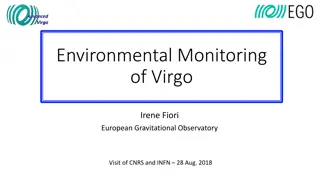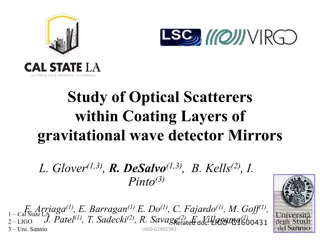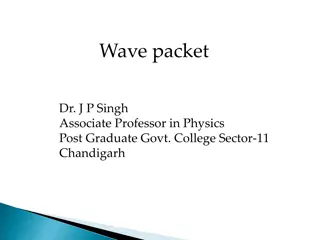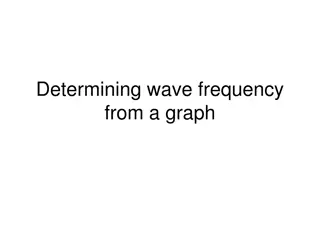Cutting-Edge Developments in Gravitational Wave Detection at MAGIS-100
Discover the groundbreaking MAGIS-100 Matter-Wave Atomic Gradiometer Interferometric Sensor, a 100-meter baseline atom interferometer under construction at Fermilab. Explore the mid-band science potential, sky localization precision, and long-baseline AI applications for gravitational wave detection and dark matter probe. Uncover the roadmap design parameter targets and the immense discovery potential in astrophysics and cosmology offered by this innovative technology.
Download Presentation

Please find below an Image/Link to download the presentation.
The content on the website is provided AS IS for your information and personal use only. It may not be sold, licensed, or shared on other websites without obtaining consent from the author.If you encounter any issues during the download, it is possible that the publisher has removed the file from their server.
You are allowed to download the files provided on this website for personal or commercial use, subject to the condition that they are used lawfully. All files are the property of their respective owners.
The content on the website is provided AS IS for your information and personal use only. It may not be sold, licensed, or shared on other websites without obtaining consent from the author.
E N D
Presentation Transcript
Matter-wave Atomic Gradiometer Interferometric Sensor (MAGIS-100) Rencontres de Moriond: Gravitation Jan Rudolph Stanford University March 23, 2023
100m Detector Facility at Fermilab MINOS Building Matter wave Atomic Gradiometer Interferometric Sensor 100-meter baseline atom interferometer under construction at Fermilab Prototype gravitational wave detector in the mid-band (0.03 3 Hz) Intermediate step to full-scale (km baseline) detector Probes for ultralight wave-like dark matter beyond current limits Tests of quantum mechanics on unprecedented scales
MAGIS Roadmap Design parameter targets for MAGIS-100 and follow-on detectors [1] [1] Abe et al., Quantum Sci. Technol. 6, 044003 (2021)
Mid-band Science Mid-band discovery potential Historically every new band/modality has led to discovery Observe LIGO sources when they are younger Astrophysics and cosmology Black hole, neutron star, and white dwarf binaries Ultralight dark matter discovery potential Early universe stochastic sources? (cosmic GW background) Optimal for sky localization Predict when and where events will occur (before they reach LIGO band) Observe run-up to coalescence using electromagnetic telescopes
Sky Position Determination Sky localization precision [2]: Mid-band advantages: Small wavelength Long source lifetime (~months) maximizes effective R R [2] Graham et al., Phys. Rev. D 97, 024052 (2018) Images: R. Hurt/Caltech-JPL; 2007 Thomson Higher Education
Long-baseline AI Science Mid-band gravitational wave detection LIGO sources before they reach LIGO band Multi-messenger astronomy: optimal band for sky localization Cosmological sources Ultralight wave-like dark matter probe Mass <10-14 eV (Compton frequency in ~Hz range) Scalar- and vector-coupled DM candidates Time-varying energy shifts, EP-violating new forces, spin-coupled effects Tests of quantum mechanics at macroscopic scales Meter-scale wavepacket separation, duration of seconds Decoherence, spontaneous localization, non-linear QM, Rb wavepackets separated by 54 cm [3] [3] Kovachy et al., Nature 528, 530 533 (2015)
MAGIS Experimental Concept Passing gravitational waves cause a small modulation in the distance between objects: L [1 + h sin( t )] Clock Atom Baseline Strain Detecting this modulation requires two ingredients: Inertial references Freely-falling objects, separated by some baseline Insensitive to perturbations from non-gravitational forces L Clocks A means to precisely monitor their separation Measure the time for light to cross the baseline via comparison to a precise phase reference Clock Atom In MAGIS atoms play both roles (active test masses) single baseline gravitational wave detector
Clock Atom Interferometry 3Pj Two-level system separated by optical frequency difference ?? Coupling to metastable state via narrow line (with single laser) [4] 87Sr 698 nm 1 mHz 1S0 Same line used in optical atomic clocks (87Sr, 1S0 3P0) Atom dwells in metastable state and evolves extra clock phase [5] 1 1 +1 2 ? ???? 2 | 2 | Clock phase doesn t cancel in symmetric MZ under acceleration ? ~?? ? ? ?2 [4] Graham et al., Phys.Rev. Lett.110, 171102 (2013) [5] Dimopoulos et al. - Phys. Rev. D 78, 042003 (2008)
Clock Gradiometry Two clock interferometers across a baseline L Laser noise is common-mode suppressed Leading order phase shift ? ? ? ~ ? ?? ? = 2 Dark matter Gravitational waves Compatible with large momentum transfer (LMT) techniques Sensitivity scales with LMT order n Promising tool for fundamental physics exploration [4, 6] [4] Graham et al., Phys.Rev. Lett.110, 171102 (2013) [6] Arvanitaki et al., Phys. Rev. D 97, 075020 (2018)
MAGIS-100 Operating Modes [1] Abe et al., Quantum Sci. Technol. 6, 044003 (2021)
MAGIS System Overview Vacuum tube Magnetic shield Structural support [1] Abe et al., Quantum Sci. Technol. 6, 044003 (2021)
Detector Location at Fermilab MINOS building and access shaft at Fermilab
Future International Network of Atomic Sensors AION: Atom Interferometer Observatory and Network (UK) MIGA: Matter Wave laser Interferometric Gravitation Antenna (France) ZAIGA: Zhaoshan Long-baseline Atom Interferometer Gravitation Antenna (China)
Summary & Status Stanford 10m Prototype Summary New kind of atom interferometer Ideally suited as a mid-band gravitational wave detector Pathfinder for km-scale instrument Probes for wavelike ultralight dark matter Tests quantum mechanics in new regimes Status Part of a future network of detectors Finalizing 10m-scale prototype at Stanford Demonstrated clock AI techniques Mature detector design Started construction on many components Awaiting laser lab construction at Fermilab [1] Abe et al., Quantum Sci. Technol. 6, 044003 (2021)
Collaborators Stanford Team Mahiro Abe Samuel Carman Benjamin Garber Yijun Jiang Megan Nantel Hunter Swan Michael Van de Graaff Thomas Wilkason and Jason Hogan Mahiro Abe Philip Adamson Evan Angelico Marcel Borcean Daniela Bortoletto Kieran Bridges Samuel Carman Steve Chappa Swapan Chattopadhyay Zilin Chen Jonathon Coleman Noah Curfman Kenneth DeRose Tejas Deshpande Savas Dimopoulos Mike Dinnon Bill Dymond Gedminas Elertas Christopher Foot Josef Frisch Benjamin Garber Steve Geer Valerie Gibson Jonah Glick Peter Graham Steve Hahn Cecilia Hanna Roni Harnik Leonie Hawkins Sam Hindley Jason Hogan Henry Hunt Dirk Hurd Yijun Jiang Michael Kagan Mark Kasevich Ronald Kellett Mandy Kiburg Tim Kovachy Jim Kowalkowski Joseph Lykken John March-Russell Jeremiah Mitchell Martin Murphy Sergei Nagaitsev Megan Nantel Lucy Nobrega Alyssa Payleitner Robert Plunkett Surjeet Rajendran Roger Romani Jan Rudolph Natasha Sachdeva Murtaza Safdari James Santucci Ariel Schwartzman Ian Shipsey Hunter Swan Dylan Temples Linda Valerio Michael Van de Graaff Arvydas Vasonis Maxine Vandegar Erik Voirin Yiping Wang Daniel Weatherill Thomas Wilkason Daniel Wood GBMF7945 QuantiSED 2019
